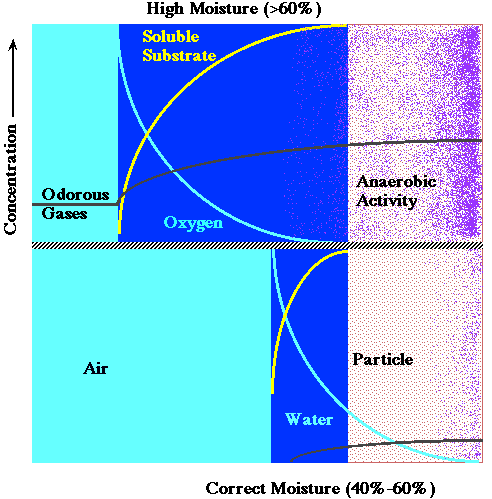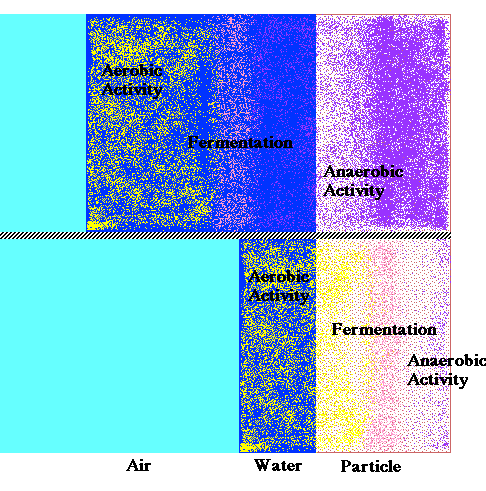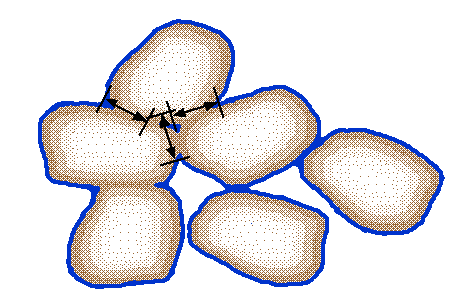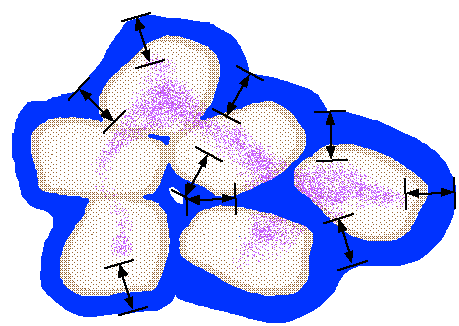
Because oxygen diffuses so much slower in water than in air, excess moisture reduces oxygen penetration. This reduction occurs in two ways. First, because moist compost is hydrophilic (it loves water), water is strongly held to the surfaces of particles, so as water content increases the thickness of the aqueous film surrounding each particle increases. The second, closely related effect, is a matrix effect due to capillarity -- water fills the smallest pores first, and thus creates water filled zones between particles, which slow oxygen diffusion and result in anaerobic clumps.
Moisture and aqueous film thickness
Figure 1 is an illustration of the first effect, aqueous film thickness, at the scale of an individual particle.

The top half of the figure illustrates a particle with a thick film of water, while in the lower half of the figure the film thickness is considerably reduced. Note that in both cases the substrate concentration is high at the particle surface, the oxygen concentration is high at the air/water interface, and the oxygen concentration decreases as it moves into the film and substrate is oxidized. In the interior of the particle, where the oxygen concentration approaches zero, anaerobic metabolic activity (indicated by purple dots) produces odors, some of which are oxidized as they diffuse out toward the airstream. With a thick layer of water (which typically occurs with moisture contents greater than 60%), oxygen is depleted before it can fully penetrate the aqueous film, and the levels of odorous gases generated in the anaerobic zone is so high that even after some oxidation in the outer layers of the aqueous film, they are detectable in the airstream. When the aqueous film is thinner (moisture contents between 35 and 60%), oxygen penetrates further, odor concentrations in the liquid are lower, and they are oxidized before they can diffuse back out into the airstream.
Figure 2 illustrates the effects of moisture content on the location of aerobic, fermentation, and anaerobic zones within a particle and in the aqueous film surrounding it. Regions of primarily aerobic metabolism are indicated with yellow dots, the fermentation zone is indicated with pink dots, and anaerobic metabolic regions are indicated with purple dots. Although many of the most offensive odors are anaerobically generated, fermentation can generate alcohols and other "sweet" or "silage" type smells which some people may find offensive. If these fermentation odors are prevalent they indicate large areas of the composting system are anoxic (without oxygen), and any further restrictions on oxygen transport may lead to anaerobic odor problems. Alcohols and other fermentation products, like the anaerobic odors, will degrade aerobically if given sufficient opportunity.

The second limitation of increasing moisture content on oxygen diffusion is through the filling of small pores with water, often dramatically increasing the distance oxygen must diffuse through the aqueous phase. The effective size of pores filled at different moisture contents can be analyzed on the basis capillary theory and matric potential relationships, applying approaches developed for soil physics and porous media.
The resulting anaerobic zones within an otherwise aerobic matrix are illustrated by the contrast between figures 3 and 4. In figure 3, the compost is at an appropriate moisture content, with aqueous films surrounding particles and air filled pores between particles. The arrows indicate a hypothetical depth that oxygen can penetrate from an air filled pore, which in this case completely penetrates all the particles.

Figure 4 illustrates those same particles with a higher moisture content. Note that all but the largest pores have filled with water, leading to considerable regions of anaerobic activity

With most composting materials, as moisture content increases beyond about 60%, the pores will rapidly fill and anaerobic conditions will result. But even at normally acceptable moisture content, anaerobic conditions are likely if compaction or small particle sizes lead to inadequate porosity.
|
Composting |
Engineering |
|
Cornell Waste Management Institute ©1996
Cornell University
Ithaca, NY 14853
607-255-1187 *
cwmi@cornell.edu